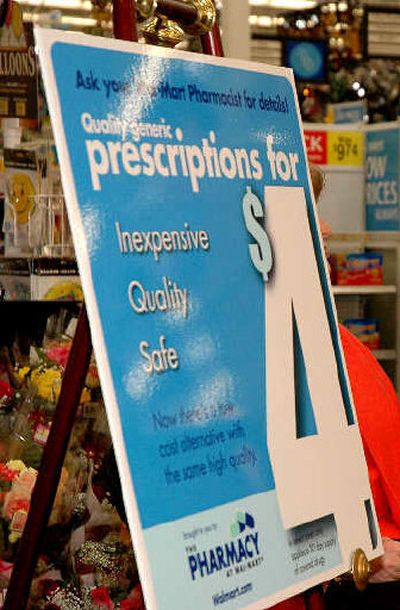Wal-Mart cuts generic drug prices

NEW YORK — First Wal-Mart drove toy sellers, then supermarkets into retreat. On Thursday, the world’s largest retailer took aim at drug chains with a plan to slash the price of generic prescriptions to $4 a month.
Wal-Mart Stores Inc. will launch its program, covering 291 generic drugs, today at 65 Wal-Mart, Neighborhood Market and Sams’ Club pharmacies in Florida’s Tampa Bay area, a haven for senior citizens. It will be expanded statewide in January and to the rest of the country later in the year.
The drugs include some of the most commonly prescribed drugs such as Metformin, used to treat diabetes, and the high blood pressure medication Lisinopril.
Analysts said consumers will save an average of 20 percent and up to 90 percent in some cases.
That will be a challenge to competing pharmacy chains and makers of generic drugs, though they shrugged off any suggestion of a threat.
Wall Street was wary about the news. Wal-Mart shares slipped slightly, while big pharmacy chains like Walgreen’s and CVS were down more on fears of lost market share. Stocks in prescription drug management companies and some generic drugmakers fell as well.
Wal-Mart said it will be able to cut prices with savings in logistics and technology, as well as working directly with generic makers to improve efficiency.
Analysts said the risks to Wal-Mart are slim because profit margins on most of the drugs already are low as they have been on the market for a while — and the program could help the Arkansas-based retailer address an image problem stemming from its policies on health insurance coverage for employees.
“They are doing something that may be good for consumers, but they don’t have altruistic motives,” said Patricia Edwards, a portfolio manager and retail analyst at Wentworth, Hauser & Violich in Seattle. “They are capitalists. They still need to make a profit.”
Tampa Wal-Mart pharmacy customer Pat Sullivan, a retired Massachusetts policeman, welcomed the idea.
“I’m on disability and my benefits run out by the end of the month,” he said. “It comes down to where do I go for a $100 prescription? I have no outlet other than to break a pill in half and take half today and half tomorrow.”
The $4 prescriptions are not available by mail order and are being offered online only if picked up in person in the Tampa Bay area.
“We’re able to do this by using one of our greatest strengths as a company — our business model and our ability to drive costs out of the system, and the model that passes those costs savings to our customers,” Bill Simon, executive vice president of the company’s professional services division, said in announcing the plan at a Tampa Wal-Mart. “In this case, we’re applying that business model to health care.”
Simon said in a conference call with reporters that the generic drugs would not be sold at a loss to draw customers into the stores, a strategy that has been used in Wal-Mart’s toy business.
David W. Maris, an analyst at Banc of America, said in a report Thursday that the plan could “squeeze the generic manufacturers.” But Simon disputed that, saying Wal-Mart is working with the 30 participating drug companies to help them be more efficient. “We are working with them as partners. We are not pressuring them to reduce prices,” the Wal-Mart executive said.
Kathleen Jaeger, president and CEO of the Generic Pharmaceutical Association, said Wal-Mart’s plan will have “little impact” on its members.